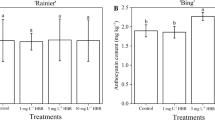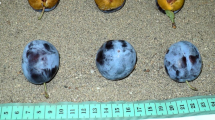Abstract
The objective of this study was to examine the potential of Solanum scabrum to provide a colorant for food. We conducted a field trial with eight accessions from four different sources and recorded both morphological variability and fruit yield differences between accessions. Further, anthocyanin and glucoalkaloid concentrations were determined. The accessions could be assigned to two distinct groups: a leafy vegetable type with toxic fruits used in Africa and a berry type with edible fruits known as Garden Huckleberry in North America, but both types had edible leaves with low glucoalkaloid concentrations. The leafy vegetable type set not much fruit. In contrast, the berry type yielded on average 800–900 g berries per plant with remarkable high anthocyanin concentrations of 8.1–13.9 g kg−1 fresh weight, calculated as petunidin 3-p-(coumaryl-runtinoside)-5-glucoside. Thus, S. scabrum can serve as a source for natural anthocyanin pigments. In particular, two accessions with a high fruit yield were promising candidates as a berry crop. One had the best anthocyanin concentration of the examined material and the other one had a low percentage of unripe berries as a further advantage.






Similar content being viewed by others
References
Anonymous (1996) Wonderberry. http://www.hort.purdue.edu/newcrop/Crops/Wonderberry.html. Cited 10 Sept 2005
Anonymous (2005) Plants for a future: Database results Solanum scabrum. http://www.ibiblio.org/pfaf/cgi-bin/arr_html?Solanum±scabrum. Cited 20 Sept 2005
Arche Noah (2005) http://www.arche-noah.at/. Cited 10 Sept 2005
Berinyuy JE, Fontem DA, Focho DA, Schippers RR (2002) Morphological diversisty of Solanum scabrum accessions in Cameroon. Plant Genetic Resour Newslett 131:42–48
Chmielewski F (2005)Weather observations. http://www.agrar.hu-berlin.de/Pflanzenbau/agrarmet/. Cited 20 Sept 2005
Dehmer KJ (2001) Conclusions on the taxonomy of the Solanum nigrum complex by molecular analyses of IPK germplasm accessions. In: Van den Berg RG, Barendse GWM, van der Weerden GM, Mariani C (eds) Solanaceae V: advances in taxonomy and utilization. Proceedings of the Vth International Solanaceae Conference, July 23–29th 2000, Nijmegen. Nijmegen University Press, pp 85–96
Dehmer KJ, Hammer K (2004) Taxonomic status and geographic provenance of germplasm accessions in the Solanum nigrum L. complex: AFLP data. Genetic Resour Crop Evol 51:551–558
Dehmer KJ, Stracke S (1999) Molecular analysis of genebank accessions of the Solanum nigrum complex. In: Andrews S, Leslie AC, Alexander C (eds) Taxonomy of cultivated plants: third International Symposium. Royal Botanic Gardens, Kew, pp 343–345
Edmonds JM, Chweya JA (1997) Black nightshades. Solanum nigrum L. and related species. Promoting the conservation and use of underutilized and neglected crops. 15. Institute of Plant Genetics and Crop Plant Research, Gatersleben, Germany/International Plant Genetic Resources Institute, Rome, Italy, 113 p
Eshtiaghi MN, Knorr D (2000) Anwendung elektrischer Hochspannungsimpulse zum Zellaufschluss bei der Saftgewinnung am Beispiel von Weintrauben. LVT 45:23–27
Facciola S (1990) Cornucopia—a source book of edible plants. Kampong Publications, Vista
Fischer B (1977) ‘Instant’ fruit—It’s hard to ask more. Organic gardening and farming 24:74–75
Fontem DA, Schippers RR (2004) Solanum scabrum Mill. Record from Protabase. Grubben GJH, Denton OA (eds) PROTA (Plant Ressources of Tropical Africa / Ressources végétales de l`Afrique tropicale). Wageningen, Netherlands. http://www.prota.org/seach.htm. Cited 5 Sept 2005
Francis FJ (1982) Analysis of anthocyanins. In: Markakis P (ed) Anthocyanins as food colors. Academic Press, New York, pp 181–207
Francis FJ (1989) Food colorants. Anthocyanins. Crit Rev Food Sci Nutrition 28:273–315
Francis FJ, Harborne JB (1966) Anthocyanins of the garden huckleberry, Solanum guineense. J Food Sci 31:524–528
Fuleki T, Francis FJ (1968) Quantitative methods for anthocyanins. 1. Extraction and determination of total anthocyanin in cranberries. J Food Sci 33:72–77
Grassert V, Lellbach H (1987) Untersuchungen des Glykoalkaloidgehaltes von Kartoffelhybriden mit Resistenz gegen die Kartoffelnematoden Globodera rostochiensis und Globodera pallida. Biochem Physiol Pflanz 182:473–479
Jacoby A, Labushagne MT, Viljoen CD (2003) Genetic relationships between Southern African Solanum retroflexum Du. and other related species measured by morphological and DNA markers. Euphytica 132:109–113
Jansen G, Flamme W (2006) Coloured pototoes (Solanum tuberosum L.)—anthocyanin content and tuber qualitiy. Genetic Resour Crop Evol 53:1321–1331
Jones CM, Mes P, Myers JR (2003) Characterization and inheritance of the anthocyanin fruit (Aft) tomato. J Heredity 94:449–456
Knorr D, Geulen M, Grahl T, Sitzmann W (1994) Food application of high electric field pulses. Trends Food Sci Technol 5:71–75
Lobin W (2004) Botanische Gärten der Friedrich-Wilhelms-Universität Bonn, 53115 Bonn, Germany, e-mail of 12 Nov 2004
Mansfeld R (1986) Verzeichnis landwirtschaftlicher und gärtnerischer Kulturpflanzen (ohne Zierpflanzen), Akademie Verlag, Berlin (2), neubearb. und wesentlich erw. Aufl., Band III, p 1191
MacKenzie J (1999) Yard and garden. Brief: garden huckleberry. http://www.extension.umn.edu/yardandgarden/ygbriefs/h201huckleberry.html. Cited 10 Sept 2005
Olet EA, Heun M, Lye KA (2005) African crop or poisonous nightshade; the enigma of poisonous or edible black nightshades solved. Afric J Ecol 43:158–161
Pelzmann H (2005) Experimental Field Station LVA Wies, 18551 Wies, Austria, letter of 22 Feb 2005
Pistick K (2004) Institute of Plant Genetics and Crop Plant Research(IPK), 06466 Gatersleben, Germany, e-mail of 12 Nov 2004
Price CL, Wrolstad RE (1995) Anthocyanin pigments of Royal Okanogan Huckleberry juice. J Food Sci 60:369–374
Seed Savers Exchange 2005. http://www.seedsavers.org/. Cited 10 Sept 2005
Soh BN (2006) Recovery of a stable, polyphenoloxidase- inactive and starch- free red- hue colorant (Anthocyanin pigment) from purple- fleshed potatoes (Solanum tuberosum L.), Diploma thesis, Technical University Berlin, Department of Food Biotechnology and Food Process Engineering
Töpfl S, Heinz V, Knorr D (2005) Overview of pulsed electric field processing for food. Emerging Technol Food Process. D.-W. Sun. Oxford, Elsevier, pp 67–97
Triquart E (1997) Mechanisierte Ernte kleinfrüchtiger Wildfruchtarten. In: Beiträge gehalten anlässlich der 1. Internationalen Wildfruchttagung. Schriftenreihe des Fachgebietes Obstbau, Humboldt-Universität zu Berlin, 11, p 103
van der Weerden G (2004) Botanical and Experimental Garden, Radboud University, 6525 ED Nijmegen, The Netherlands, e-mail of 3 Nov 2004
VERN (2005) Verein zur Erhaltung und Rekultivierung von Nutzpflanzen in Brandenburg e. V. http://www.genres.de/infos/vern/. Cited 5 Sept 2005
Wrolstad RE, Durst RW, Lee J (2005) Tracking color and pigment chages in anthocyanin products. Trends Food Sci Technol 16:423–428
Author information
Authors and Affiliations
Corresponding author
Rights and permissions
About this article
Cite this article
Lehmann, C., Biela, C., Töpfl, S. et al. Solanum scabrum—a potential source of a coloring plant extract. Euphytica 158, 189–199 (2007). https://doi.org/10.1007/s10681-007-9442-2
Received:
Accepted:
Published:
Issue Date:
DOI: https://doi.org/10.1007/s10681-007-9442-2




